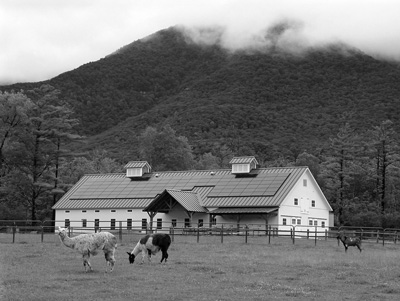Arts & Culture
More than a museum
On Hildene’s 400-plus acres, focus turns to ecological stewardship

By TELLY HALKIAS
Contributing writer
MANCHESTER, Vt.
Stately historic properties make fine museums, though once visitors have seen some of these grand old estates they may figure they’ve already had the full experience.
But Hildene, the Lincoln family home in Manchester, has spent the last decade planning and working toward becoming more than just a museum. Instead, it is evolving into a working farm and estate poised to take advantage of 21st century interests in environmental stewardship and sustainability.
Seth Bongartz, Hildene’s president, said the extensive work undertaken in recent years to support this transformation is about to yield a series of new benefits for visitors.
“After years of discussion and planning we will, on June 1, begin incorporating Hildene Meadows and the adjacent Batten Kill wetlands into the daily guest experience,” Bongartz said. “This is a gorgeous, interesting and ecologically diverse part of the property. It is also a financial imperative: We need to put every bit of our 412 acres to work advancing our mission and contributing income to the restoration and maintenance of our extensive infrastructure.”
Hildene Meadows, a sprawling grassy area long used for craft shows and other large-scale public events, has in the past couple of years been closed to prepare for a transition to agricultural use.
Laine Dunham, Hildene’s vice president, said a decade of work on the upper parts of the property will soon give way to initiatives on the lower half.
“We must become more sustainable, and the meadows are part of that,” Dunham said. “Plans right now include a new greenhouse, vegetable gardens, flower crops and a composting facility.”
Hildene already composts goat waste from its cheese production facility, and it plans to add garden, farm and food waste to the mix. The resulting compost will then be used to help fertilize all of Hildene’s crops.
Last year, Hildene completed a footpath along the Batten Kill wetlands and a 600-foot-long floating boardwalk. The boardwalk is part of Hildene’s long-term land management plan, which calls for demonstration areas to enhance casual visits and educational programming, the latter primarily for elementary students. Visitors will learn about the ecological importance of the meadows and wetlands and how they help to provide habitats and food for bees, butterflies and songbirds.
Lincoln family estate
Hildene is the legacy of Robert Todd Lincoln, eldest son of Abraham and Mary Todd Lincoln, and the only one of their four children to reach adulthood. A Harvard graduate, he went on to serve as secretary of war, U.S. ambassador to the United Kingdom, and counsel, president and chairman of the Pullman Palace Car Co., where he served until his death in 1926.
Famous for years for the main house at its center, and more recently with a fully restored Pullman railroad car added to its offerings, Hildene clearly is a historic site. But it’s more. The natural resources and geographic diversity of the property have made possible interpretive ecology exhibits, heirloom gardens, beekeeping, miles of trails for nature discovery, and an agricultural center with a cheese-making facility.
Hildene has a potpourri of attractions, each with a distinct identity. The carriage barn, built around 1905, has had its century-old wood restored to original condition. The museum store and welcome center include interactive displays and feature a variety of environmentally friendly goods.
Press director Paula Maynard said Hildene is becoming known increasingly for more than the manor, and in its new form is increasingly true to its mission of “values into action.”
“These estates, grand as they were, also had a significant sustainable element to them, and it started with agriculture,” Maynard said. “It’s important to remember that Hildene is a working farm and intends to continue that endeavor.”
 Both Robert Todd Lincoln, a gentleman farmer, and his granddaughter, Peggy, a hands-on farmer, valued Hildene’s agricultural potential. Each raised a dairy herd and chickens that produced eggs, milk and butter used on the estate and shared with friends. This established a precedent for one of Hildene’s major projects of the past decade, the Rowland Agricultural Center.
Both Robert Todd Lincoln, a gentleman farmer, and his granddaughter, Peggy, a hands-on farmer, valued Hildene’s agricultural potential. Each raised a dairy herd and chickens that produced eggs, milk and butter used on the estate and shared with friends. This established a precedent for one of Hildene’s major projects of the past decade, the Rowland Agricultural Center.
The center uses sustainable practices of the 21st century. The 40-foot-by-100-foot post-and-beam barn was built with white pine felled and milled on the estate. It now uses renewable energy from solar panels. This power, coupled with a heating system fueled by cordwood from the property, provides an opportunity to teach about the importance of renewable energy, a closed-loop forest management plan and the green value of sustainable small-scale farming.
The building houses Hildene’s herd of Nubian goats. It also allows public viewing of cheese making, from milking to processing, pasteurization, aging and packaging of Hildene Farm artisanal cheeses.
The estate makes cheese year-round using cow’s milk from local farms to produce several varieties. These cheeses are aged and ready for purchase by summer and are also used for events on the estate, another sustainable practice.
After kidding season concludes, cheese making with goat’s milk resumes. Production includes Hildene’s popular chevre, which is typically available in the fall after the four to six months of aging.
Woodlands and songbirds
Hildene’s overall land stewardship is reflective of its first-ever comprehensive land management plan, completed in 2006. Although the estate had engaged in some timber management since the 1970s, its emphasis now is on the entire forest ecosystem.
Alan Calfee, president of Calfee Woodland Management and Hildene’s consulting forester, said the efforts on the estate since he arrived in 2005 have been “commendable and courageous.”
“Anytime you are dealing with an organization that has to make strategic decisions on its future, finances are affected,” Calfee said. “As a result, land stewardship is one of the first things to be cut in favor of commercialism. Much to its credit – and it isn’t the easy way to go – Hildene has resisted that temptation.”
One goal of the land management plan was to harvest Hildene’s own timber, such as that included in the Rowland center’s construction as well as the many cords needed to fuel the estate’s wood-burning furnaces.
Calfee said these efforts were in line with sound principles of harvesting and a longer-term goal of enhancing the forest’s structural diversity. This directly leads to addressing the natural diversity of species, including songbirds.
The forests of northern New England are the nesting habitat for a wide variety of migratory songbirds, and for some species, this region is where a significant portion of their entire breeding population comes to raise their young. Among these are the black-throated blue warbler and the blackburnian warbler.
Other species are experiencing long-term population declines throughout their breeding range, such as the wood thrush and white-throated sparrow. The Canada warbler is an example of a species that falls under both categories.
Steve Hagenbuch, a conservation biologist with Audubon Vermont, said his organization’s Forest Bird Initiative is working to ensure that high-quality nesting habitat exists for a group of 40 bird species, called “responsibility species,” that breed in large numbers in northern New England but are considered at risk.
“One of the main strategies for achieving our conservation objectives is to work directly with the people who steward the forest resource, which in Vermont is primarily the private landowner,” Hagenbuch said. “By helping landowners understand the role their forestland plays in global bird conservation, we hope they will include bird habitat considerations in the management of their forest.”
Last year, Hagenbuch conducted Hildene’s first forest bird habitat assessment, at Calfee’s request. He was able to characterize the types and quality of nesting habitat for bird species characteristic of the forest types in southern Vermont.
After this fieldwork, he developed recommendations related to bird habitat to be incorporated into Hildene’s forest management activities.
Pollinator paradise
One of the final pieces of the natural overlay integrated into Hildene’s transformation is creating and sustaining a pollinator-friendly habitat.
Having eliminated pesticides from its expansive lawns and gardens, Hildene has made other modest adjustments to its farming practices and forestry plan, putting its property on the cusp of becoming a wildlife sanctuary focused on bees, butterflies and songbirds.
Diane Newton, Hildene’s education director, said one of every three bites of food humans eat is from crops pollinated by insects, primarily bees. Nearly three-quarters of all plants rely on pollinators such as butterflies, bees, moths, beetles, birds and bats. But she said many of these pollinators are now threatened, so there’s a need for education – and corrective action.
“Our pollinator education focuses mostly on groups from elementary schools,” Newton said. “It’s so important to reach them at a young age and inculcate this crucial need for our ecosystem.”
Dunham, Hildene’s vice president, said the estate’s mission and its role as a museum are enhanced by its ongoing environmental planning and development.
“When we say ‘values into action,’ we aren’t just parroting a slogan,” s
he said. “Moving forward on all these initiatives is what will make Hildene thrive in the new century -- in a way all Americans can be proud of.”
Hildene is at 1005 Hildene Road, just off Route 7A in Manchester. The Lincoln Family Home at Hildene is open from 9:30 to 4:30 daily. For more information, visit hildene.org or call (802) 367-1788.

